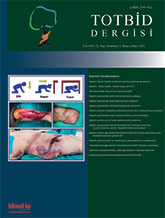
Since 2000, earthquakes have caused more than 800.000 deaths and even more injuries worldwide. 87% of earthquake- related injuries are orthopedic injuries and 22% of these are open fractures. Considering that our country is located in the earthquake zone and the incidence of open fractures in earthquake injuries is so high, the importance of open fracture management in earthquake injuries emerges once again. Open fractures are fractures where the bone is exposed to the external environment by losing the integrity of the soft tissue at or near the fracture site. Patients admitted to the hospital with an open fracture after an earthquake should be assumed to be contaminated at the time of admission. First of all, the patient should be evaluated in terms of vital functions (airway, respiration and circulation). Patients should be carefully evaluated in terms of crush syndrome and compartment syndrome, which are frequently seen after earthquakes. Considering that debridement will be performed in the operating room as soon as possible, open wounds should be photographed in the emergency room and covered in a sterile manner. The patient`s extremity should be stabilized and immobilized as much as possible. The tetanus vaccine of the patient should be questioned, if necessary, tetanus vaccine should be administered in the early period and antibiotic therapy should be started. Radiologic imaging of the extremity should be performed, and in operating room conditions, emergency debridement and irrigation should be performed. The skeletal system should be stabilized temporarily or permanently. Repeated debridements should be applied and the open wounds should not be closed without being sure about the cleanness of the wound. Permanent stabilization of the extremity should be achieved as soon as possible and the open wound should be closed. If there is a problem in closing the open wound, soft tissue interventions may be necessary.